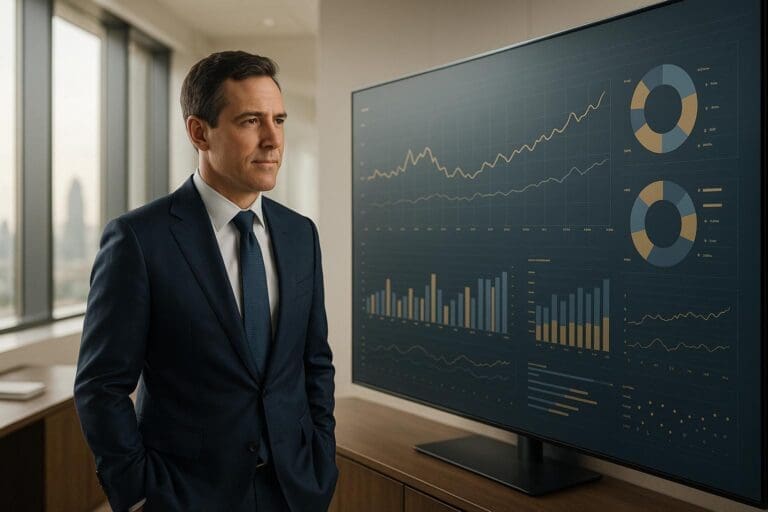Want to improve your trading system’s performance? Start by tracking these 7 key metrics:
- System Response Time: Measures how fast orders are processed. Faster response times reduce delays and slippage.
- Order Completion Rate: Tracks the percentage of successfully executed orders to ensure trading efficiency.
- Price Difference at Execution: Monitors slippage – the gap between expected and actual trade prices.
- Better Price Achievement: Evaluates how often trades are executed at better-than-expected prices.
- Total Trading Costs: Includes explicit costs (fees) and hidden costs (market impact, timing delays).
- Order Path Performance: Assesses the efficiency of trade routing across venues.
- System Uptime and Stability: Ensures continuous operation and minimizes downtime risks.
Quick Takeaway: Monitoring these metrics in real-time with tools like AI-powered analytics can help trading firms reduce costs, improve execution quality, and stay competitive in fast-moving markets.
System Response Time
System response time refers to how fast orders are processed and executed. Even small delays can result in orders being completed at less favorable prices, underscoring the importance of real-time, data-focused systems.
Faster response times allow traders to:
- Act on price changes before market conditions shift
- Minimize slippage by reducing the gap between expected and actual execution prices
- Stay competitive with timely trade execution
In volatile markets, delays can lead to trades being executed at less-than-ideal prices – especially problematic for algorithmic strategies that depend on split-second decisions.
"Real-time insights and faster decision-making are crucial for optimizing portfolio performance. Investment firms should prioritize systems that offer real-time data processing and immediate insights to enhance decision-making." – Accio Analytics
Keeping an eye on system response times can help pinpoint problem areas and improve performance as needed. Tools like Accio Quantum Core provide real-time monitoring, helping firms maintain peak performance and quickly adapt to changing market conditions.
Order Completion Rate
Order completion rate measures the percentage of orders successfully executed out of the total orders placed. Even small changes in this rate can affect trading outcomes, especially for institutional traders handling large portfolios.
Advanced platforms provide real-time tracking, allowing traders to monitor this metric closely. This helps them make quick adjustments to their strategies to keep up with the rapid pace of today’s markets.
Price Difference at Execution
Execution slippage measures the gap between the price you expect to trade at and the actual price you get. This difference can affect both costs and overall portfolio performance.
Advanced analytics platforms track these price variations in real time. They can send alerts when deviations go beyond acceptable limits, helping traders take quick action and adjust to market shifts effectively.
Factors like market volatility, order size, time of day, and liquidity all play a role in price differences. Understanding these can guide strategies to better manage slippage.
Here are some ways to handle slippage:
- Keep an eye on standard deviation to identify normal ranges and spot unusual changes.
- Study time-based patterns to find the best trading windows.
- Evaluate how order size impacts execution prices to make more informed decisions.
Automated systems can instantly notify you when price changes exceed set thresholds. With customizable AI tools, you can keep price variations in check while aligning with your trading strategies and risk tolerance.
sbb-itb-a3bba55
Better Price Achievement
This metric measures how often trades are executed at prices better than the target price. It directly affects trading costs and overall portfolio performance.
Advanced platforms monitor real-time price improvements using these key parameters:
| Parameter | Description | Impact on Price Achievement |
|---|---|---|
| Market Depth | Analyzes the order book | Highlights areas for potential price gains |
| Timing Analysis | Optimizes trading windows | Pinpoints the best moments for execution |
| Volume Patterns | Examines trade size effects | Shows how size influences price advantages |
| Volatility Metrics | Tracks price movements | Identifies windows for favorable execution |
Strategies to Maximize Price Achievement:
- Standard Deviation Monitoring: Analyze price fluctuations to uncover patterns that can lead to better execution prices.
- Real-time Analytics: Respond instantly to price improvement opportunities for higher success rates.
- Custom Parameters: Tailor thresholds to fit your specific trading strategy.
To enhance your platform’s analytics, configure it to:
- Track price movements over different timeframes
- Compare achieved prices to the VWAP (Volume Weighted Average Price)
- Measure the percentage of trades with improved execution prices
- Calculate the average price improvement per trade
These tools and strategies integrate with your broader evaluation of execution performance, helping you automatically adjust order parameters to take advantage of price improvements. Next, assess how this impacts your platform’s overall cost efficiency.
Total Trading Costs
Managing costs effectively is just as important as ensuring speed and accuracy in trade execution. Total trading costs include both explicit expenses (like broker, exchange, clearing, and technology fees) and hidden expenses (such as market impact, timing delays, and bid-ask spread costs) that can chip away at profits.
Direct Costs Breakdown
| Cost Component | Description | Impact on Trading |
|---|---|---|
| Commission Fees | Fixed or percentage-based charges | Directly reduces profit margins |
| Exchange Fees | Charges for market access and data | Depends on venue and trading volume |
| Clearing Costs | Post-trade processing expenses | Adds to fixed operational costs |
| Technology Fees | System maintenance and connectivity costs | Recurring infrastructure expenses |
Beyond these direct costs, there are less obvious factors that can significantly affect overall expenses.
Hidden Cost Factors
Hidden costs like market impact, timing delays, and bid-ask spread fluctuations can add up quickly. These factors often go unnoticed but play a major role in determining the true cost of trade execution.
Cost Optimization Strategies
To reduce these expenses, traders can take several steps:
- Schedule larger orders during periods of higher liquidity.
- Track spread patterns to identify the best trading windows.
- Use historical data to fine-tune order sizes.
- Stay informed about fees specific to each trading venue.
These strategies can make a noticeable difference in managing total trading costs effectively.
Order Path Performance
Tracking metrics like system response and cost management is just the start. Diving into order path performance helps fine-tune how trades are executed.
Order path performance evaluates how efficiently trade orders move through different execution venues. It sheds light on the effectiveness of your trading setup and flags potential issues that could hurt execution quality. Just like latency and cost control, keeping an eye on order paths is key to smooth operations.
Smart Order Routing
Smart order routing (SOR) plays a big role in improving trade execution. By analyzing factors like venue response times, order distribution, and routing precision, traders can gain a clearer picture of how orders are flowing and make necessary adjustments. To keep routing effective, constant review and fine-tuning are essential.
Real-Time Path Monitoring
Real-time monitoring is critical for spotting and fixing disruptions quickly. Focus on areas such as:
- Network delays between trading systems
- Connectivity problems with trading venues
- Lags in order processing
- Routing errors or inefficiencies
Dynamic Route Adjustment
Regular monitoring naturally leads to adjustments, ensuring routing stays efficient as market conditions shift.
Adapting routing strategies to factors like market volatility, venue liquidity, and trading patterns during the day helps reduce delays and improve execution. Continuously revisiting and tweaking routing logic is essential for staying ahead in dynamic markets.
System Uptime and Stability
Maintaining system uptime and stability is essential for effective trade execution. Even a short downtime can result in missed trades and financial losses.
Continuous Monitoring
It’s important to keep an eye on several key areas to ensure smooth operations:
- Server response times
- Database health
- Network connectivity
- Application reliability
- System resource usage (like memory and CPU)
Impact on Trading Performance
System downtime can have serious consequences for trading:
- Missed Opportunities: When systems are down, time-sensitive trades can’t be executed.
- Incomplete Orders: Interruptions may lead to partial or failed order executions.
- Data Gaps: System instability can cause missing chunks of market data.
- Risk Management Challenges: Downtime can hinder real-time position monitoring.
Best Practices
To ensure system uptime and stability, follow these practices:
- Use Advanced Analytics: Set up real-time alerts to monitor performance.
- Redundancy Systems: Have backup systems ready to take over instantly.
- Load Testing: Regularly stress test your systems to handle peak traffic.
- Automated Recovery: Implement failover systems for immediate recovery.
- Benchmarking: Track performance metrics over time to identify trends and areas for improvement.
Conclusion
This section highlights the key metrics that drive successful trade execution and ensure efficient trading operations.
Trade execution depends on specific metrics that help achieve the best possible outcomes. Together, these metrics provide a clear picture of trading performance. Monitoring them in real time is crucial, as modern platforms use advanced analytics to process large datasets and deliver actionable insights instantly.
"With Accio Quantum Core, that entire process is streamlined into immediate, actionable insights."
Here’s a breakdown of the main metrics and their roles:
| Metric | Primary Function | Impact on Trading |
|---|---|---|
| System Response Time | Measures execution speed | Reduces latency-related losses |
| Order Completion Rate | Tracks successful executions | Ensures trading efficiency |
| Price Difference at Execution | Monitors price accuracy | Minimizes unexpected costs |
| Better Price Achievement | Evaluates price improvement | Maximizes trading opportunities |
| Total Trading Costs | Calculates overall expenses | Controls operational efficiency |
| Order Path Performance | Analyzes routing efficiency | Optimizes execution paths |
| System Uptime | Ensures reliable operation | Maintains continuous trading |
Each metric plays a direct role in maintaining and improving trading efficiency.
To make the most of these insights, financial institutions should:
- Use real-time monitoring: Set up automated alerts to flag any deviations in performance.
- Define clear benchmarks: Establish measurable targets for each metric to guide operations.
- Continuously refine systems: Regularly analyze metrics and adjust system settings as needed.
- Adopt advanced analytics tools for predictive and data-driven decisions.




